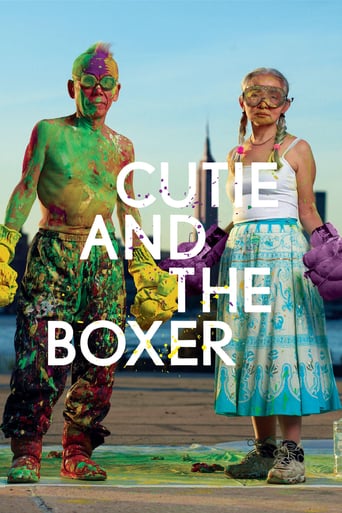

CUTIE AND THE BOXER is a no-holds barred documentary focusing on the 40- year marriage of Ushio Shinohara and his wife Noriko. Ushio established his reputation in Japan as a leading avant-garde artist before emigrating to the United States; since his marriage in the early Seventies, it's clear he has assumed a dominant role as artist and alcoholic, seldom taking much notice of his wife, also an artist. Zachary Heinzerling's film shows how Noriko carved out a niche for herself by creating designs for herself, focusing on a character called Cutie and her struggles for self-determination. The subjects of such designs are very closely related to Noriko's own life; it's clear she has experienced a difficult time trying to put up with a difficult husband - who throughout his life has found it hard to make a living through his art - and a son who drinks too much. It's a tribute to her stoicism that she not only manages to retain her artistic voice, but creates designs of her own that satirize her husband. Ushio, by now a reformed alcoholic, views his wife's paintings indulgently; they don't represent a threat to his masculinity, nor his status as an artist. In truth Noriko's designs are far more expressive than her husband's - although Ushio claims to produce material that will show a "new" artist, he only ever produces copies of work created several decades previously. Director Heinzerling makes no judgment on either of the protagonists, but leaves us to make up our own minds, What is perhaps most admirable is the way the couple have stayed together through thick and thin - despite their differences, they are obviously still in love with one another.
... View MoreZachary Heinzerling's wonderful documentary "Cutie and the Boxer" is about the Japanese action painter Ushio Shinohara and his wife, the graphic artist Noriko and their life together in New York. Ushio was eighty when the film begins, (Noriko is 21 years younger than him), and it shows him at work today preparing for a new exhibition. His action paintings are created by his 'boxing' great daubs of paint onto large canvases, hence the name ' the boxer' while Noriko has created a young girl whom she calls Cutie and her graphic stories are brought beautifully to life in black and white animation. These and the film itself chart the course of their relationship, both personal and working, from their first meeting to the present day in a way that is highly original and really rather sad. Though it is obvious they really love each other the tensions of a working relationship keep bubbling to the surface. When Ushio heads off to Japan to try to sell some of his work Noriko almost feels happy at being left alone. The film is nominated for Best Documentary Feature at this year's Oscars and is very fine.
... View MoreZachary Heinzerling's documentary is crafted as masterfully as any art film I've seen. The subjects–two Japanese-American artists who work in New York City, Ushio and Noriko Shinohara. Accented by telling moments and minutes of silence, thought, and reminiscences, the film exposes one of the truly beautiful and mystifying characteristics of the Japanese language. So much is exposed in so very few words, but those words are accompanied by expressions of emotion and 'understood' acknowledgments that seem unfinished or cut off to someone who does not speak Japanese. As an appropriate demonstration of the expression of these two lives and the communication they've shared, the film is framed by live creation of art by the two artists. Ushio creates "action painting" by hitting a canvas with sponges attached to boxing gloves, and Noriko composes a story in drawings creating the character "Cutie" based on her own life, but with elements that are only realized in Noriko's fantasies.One of the most striking things about this film is the fact that it captures moments that seem unbearably awkward to me but are received matter-of-factly by Ushio and Noriko in turn. There is a sense of pride present in Ushio, which he expresses unabashedly at times in the film, but there are also incredibly humbling moments of relinquishing that pride that delivered by an American artist may come off as tongue-in-cheek, but delivered by Ushio is completely straightforward and blanched. His situation is what it is, there is no reason to try to disguise it. Their ceiling is leaking and they may not be able to pay rent this month. Shikata ga nai, "It can't be helped." The two of them were brought together by the connection and agreement they shared when considering their art to be the absolute priority of their lives. This focus unfortunately caused a deterioration in other parts of their life together, particularly when Noriko has a child. The life of these struggling artists seems to have been punctuated by long periods of distraction. Because in reality, especially trying to live in New York City, art cannot always be the 24/7 preoccupation you want it to be, there is an alternative mindset that may take the place of despair, one that colors the world with the colors similar to the artist's palate, keeping the shelf prepped and continuously in view no matter what else is going on. Noriko and Ushio have long ago determined to live their lives the way they alone see their lives. One of full of color and life, necessary sadness and equally necessary resilience. I don't think that their perspectives lack recognition of the regrets they carry with them, as their discussion of their son's alcoholism similar to his father's demonstrates. The film utilizes close-ups of Noriko in particular to highlight the presence of pain, but it does not run rampant in her mind, knocking over tables. Instead it seems like a silent observer, taking in the reality around it without trying to escape in any way.The varied and abrupt cuts throughout the film create a patchwork that for me makes the film seem like I am looking through a photo album instead of following a narrative, and I like this. It's like walking through an art gallery where many different themes and impressions are introduced and it is up to the viewer to take in what he or she will and to assign relevance where it lies in each mind.
... View MoreAge is a funny thing. Most days I really feel my age, but from outward appearances, most people guess well below my actual years.As we age, we tend to think of dying and disease. One of the partners in a marriage is usually suffering more than the other. You have to sometimes forget your troubles to tend to the other.This film is about a married couple who have reached that point in their lives. We see how they see themselves and their partner. Noriko willingly made sacrifices for Ushio, but now she wants to develop her own interests.The dance between these two artists is fascinating, tender, and sometimes loud, but never boring.
... View More